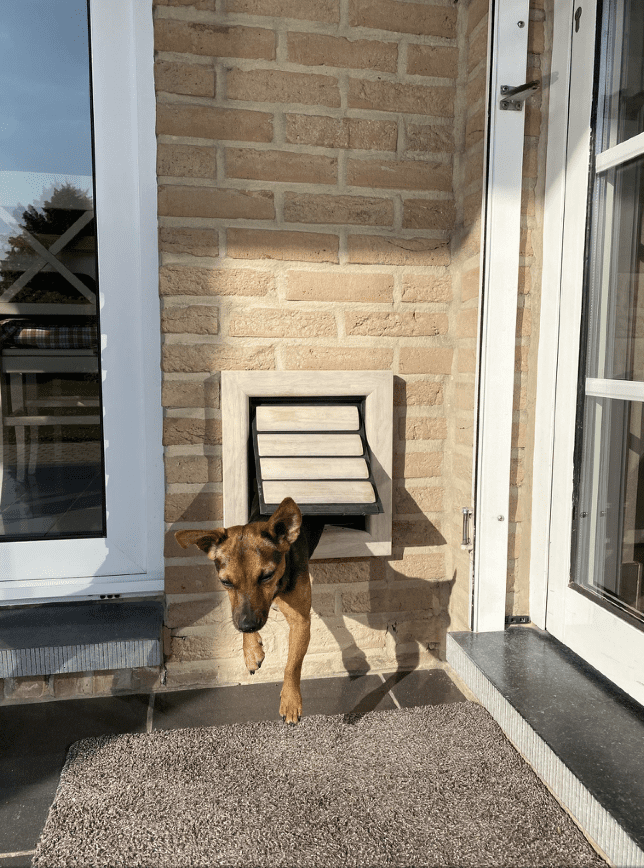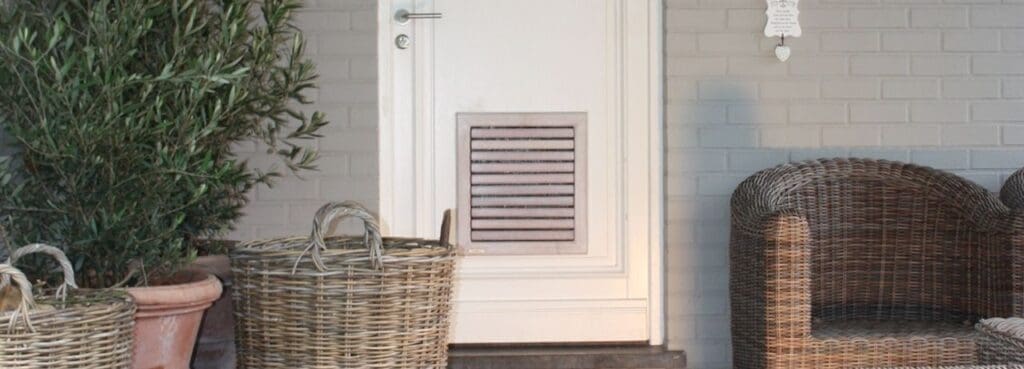Being able to decide to enter & leave the nest is as natural for an animal as for us with our home. But still …. leaving the nest can be difficult because of unsafe feelings, or: just as a mum checks her child’s coat before going outside, your dog or cat is used to the comfortable ritual of you opening the door, indicating that it’s okay to go out. We can’t know this in advance, but it’s possible your pet does not immediately “take” to the pet door and thus needs some help.
The pet door will be installed on a good day but how do you go about this?
Step 1
It’s OKAY to go in and out by yourself !
If your dog or cat is used to you opening the door, a part of their safety suddenly disappears: now they have to dare to go outside on their own. One pet doesn’t care, while another might be a bit scared. Pushing them out certainly doesn’t help (how would you feel?), nor putting treats outside, as it does not ease the fear.
So what does work?
The cat in the picture has the right approach: first popping her nose outside. Some are quick learners, and for the slowpokes, you can keep the flap open with a piece of tape. Should you then go outside and do all kinds of things that your pet finds interesting, you will certainly motivate your cat or dog this way to step out into the world on their own.


Step 2
It’s FUN to go in & out by yourself!
Know that the first step of gaining the confidence to step outside independently can take a long time. Sit outside in the sunshine with a book or do something you can keep up for a while, so your cat or dog has time to build confidence inch by inch. Call them now and then but give them time if they don’t react immediately. They heard you, and they know what you want.
When they come outside for the first time, reward them enthusiastically and then immediately call them back inside through the pet door with a treat, then quickly back out with a treat again and keep repeating this enthusiastically. Make it a fun indoor and outdoor game. It might be more practical to do this with two people: someone inside and someone outside. This way, remaining fears will fade away.
Step 3
It’s NORMAL to go in & out by yourself
Some pets understand it now, and they will dash in & out, but not all pets are like that. If you notice that your dog wants to go outside but doesn’t immediately use the pet door, then go back to step 1: call him from the outside and be patient. When he comes out, directly move on to step 2: reward him with a treat and call him back inside with a treat, then back outside but no treat this time; hug him instead and quickly phase-out the treats. Stay out with him for a while and then go back inside alone. And what if he doesn’t want to use the pet door, but stands in front of the door? The same scenario, call him inside through the pet door.
And of course, inform other housemates as well: don’t give in and don’t pay any attention when cat or doggy-dear pretend to have forgotten about their pet door and are begging at the door again for you to let them out. It’s attention-seeking: go outside, do something fun, and they will be out in no time … via the pet door!
Some dogs or cats are frightened by the flap on their backs. Then you can best keep the flap open by hand when your pet comes through, and then lower it gently with your hand so it becomes a caress.
We have these Tips & Tricks from customers, and from expertise of Augie from Flappies. We’d love to hear about your experiences!

